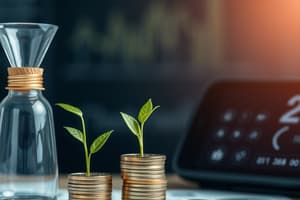Podcast
Questions and Answers
What is the primary purpose of saving?
What is the primary purpose of saving?
- To generate income through investments
- To invest in real estate
- To address short-term goals (correct)
- To accumulate funds for long-term goals
What is the key difference between financial assets and real assets?
What is the key difference between financial assets and real assets?
- Financial assets are more risky, while real assets are more stable
- Financial assets are tangible, while real assets are intangible
- Financial assets are more liquid, while real assets are more flexible (correct)
- Financial assets are primarily income generating, while real assets are held for long-term capital appreciation
What is the relationship between saving and investing?
What is the relationship between saving and investing?
- Saving and investing are interchangeable terms
- Every investor is a saver, but not vice versa (correct)
- Saving and investing are mutually exclusive
- Every saver is an investor, but not vice versa
What is the primary objective of investors?
What is the primary objective of investors?
What is the primary reason why individuals or households may not have matching income and spending patterns?
What is the primary reason why individuals or households may not have matching income and spending patterns?
What is the main difference between investment and speculation?
What is the main difference between investment and speculation?
What is the characteristic of financial assets that makes them attractive to investors?
What is the characteristic of financial assets that makes them attractive to investors?
What is the primary goal of investment, according to the life-cycle pattern of savings?
What is the primary goal of investment, according to the life-cycle pattern of savings?
What is the key difference between saving and investment?
What is the key difference between saving and investment?
What is the range of time periods for financial transactions?
What is the range of time periods for financial transactions?
Which of the following is NOT a characteristic of investment?
Which of the following is NOT a characteristic of investment?
What is the primary advantage of investing in financial assets?
What is the primary advantage of investing in financial assets?
What is the return on investment, according to the life-cycle pattern of savings?
What is the return on investment, according to the life-cycle pattern of savings?
What happens when individuals or households consume more than their current income?
What happens when individuals or households consume more than their current income?
Why do individuals or households make a trade-off between postponing their current consumption and an expected higher amount for future consumption?
Why do individuals or households make a trade-off between postponing their current consumption and an expected higher amount for future consumption?
What is the primary objective of those who consume more than their current income?
What is the primary objective of those who consume more than their current income?
Flashcards are hidden until you start studying
Study Notes
Investment and its Phases
- People go through various phases in their life cycle, where they earn more or less than they spend, leading to borrowing or saving.
- At times, individuals have a surplus of money, and they have two options: keep it with them until their consumption requirements exceed their income or pass it on to those who need it with the condition of returning it back with some increment.
Saving vs Investment
- Saving is the difference between money earned and money spent.
- Investment is the current commitment of savings with an expectation of receiving a higher amount of committed savings.
- Investment involves a specific time period and making the savings work to generate return.
- Saving uses short-term deposits/short-term securities, which are highly liquid assets, while investing commits funds to real assets, capital market securities, and other long-term commitments.
Objectives of Savers and Investors
- Savers tend to accumulate funds to address short-term goals.
- Investors have longer-term goals, such as building a retirement corpus or funding children's college education expenses.
- Every investor is a saver, but not vice versa.
Investment vs Speculation
- Investment and speculation activities are interconnected, but can be distinguished based on investment time horizon and the process of decision making.
- Investment involves a longer-term horizon, whereas speculation has a shorter time horizon.
Financial and Real Assets
- Assets can be broadly categorized as financial assets (e.g., shares, debentures, bank deposits) and physical assets (e.g., gold, diamonds, real estate).
- Financial assets have the advantage of greater liquidity, flexibility, and convenience of investing, and are primarily income-generating investments.
- Physical assets, such as gold and real estate, are held for long-term capital appreciation.
Studying That Suits You
Use AI to generate personalized quizzes and flashcards to suit your learning preferences.




